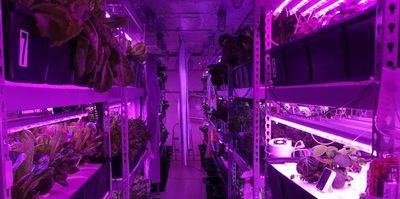Technology
Vertical Farming
Homer Farms Inc. uses its proprietary vertical farms to cultivate high-quality produce. The vertical farming system is designed by Homer Farms Inc. and will be manufactured by Homer Farms’ suppliers around the world. The vertical farming system consists of the following components:

Vertical Farm Components
Modular Growing System
Environmental Control System
Environmental Control System
The current growing system uses a deep-water hydroponic system (depth > 7 inches) and can cultivate all types of leafy greens and some fruits (e.g. strawberry). The growing system can easily scale up and down to meet local demand.
Environmental Control System
Environmental Control System
Environmental Control System
The environmental control system is designed to manage the environmental factors in the vertical farm to create an optimal growing environment for the plants. The current environmental control system can precisely control temperature, humidity, and CO2 concentrations. Temperature and humidity are controlled by the HVAC system, mini-split air conditioning, water-cool chillers, and air-cool compressors based on the size of the vertical farm and local regulations. The concentration of CO2 is controlled by CO2 generators consuming propane or methane.
LED Lighting
Environmental Control System
LED Lighting
The vertical farming system uses artificial lights rather than sunlight to achieve higher efficiency in photosynthesis. LED light currently is the best option for vertical farms, as it has high energy efficiency without generating a large amount of heat. Homer Farms Inc. is developing a new spectrum to allow plants to develop a higher tolerance for temperature change. If it works, the energy consumption will be drastically reduced, which will make the prices of Homer Farms’ products even more competitive.
Sensors
Nutrients
LED Lighting
Homer Farms Inc. uses sensors to precisely monitor the growing environment of plants. Our systems utilizer quantum sensors as well as sensors to monitor air temperature, plant temperature, humidity. The system's electrical conductivity, pH, and liquid temperature of the nutrient solution are also monitored by pH and electrical conductivity meters. All of the sensors are connected to the internet allowing remote access.
Nutrients
Nutrients
Nutrients
In our system, there are two sources of nutrients for plant growth: synthetic fertilizer and food waste derived fertilizer. Nutrients are mixed with water to be added into the deep-water hydroponic system.
Anaerobic Digestion
Homer Farms Inc. developed its proprietary anaerobic digester to process the food waste collected from its customers. The anaerobic digester primarily provides food waste derived fertilizer and bioenergy for the vertical farm to create a circular economy. The bioenergy is generated from biogas, including approximately 70% CH4, 25% CO2, 5% other gases (e.g. H2S). The biogas is filtered through a gas scrubber to remove H2O and H2S. Then the biogas is combusted in a biogas engine to generate electricity used in the vertical farm. With more advanced gas scrubbers in the near future, Homer Farms Inc. will capture CO2 in the biogas and from the engine, and make it a photosynthesis enhancer in its vertical farm to boost crop yields. The anaerobic digester consists of the following components:

Anaerobic Digester Components
Control Panel
Control Panel
Control Panel
All of the activities in the anaerobic digester is managed via the control panel. Currently, three displays show the pH inside the digester, the temperature, and the operation.
Grinder
Control Panel
Control Panel
Homer Farms Inc. uses a specifically designed grinder to process food waste to improve the fermentation efficiency in its bioreactor. The processed waste meets the requirements of Grind Level 4 in which the particle size is under 2.0 mm. The grinder also utilizes air switch control, auto-reverse system, and overload protection to reduce operational risks. The grinder cavity is insulated to keep the operation noise under 15 dB to make the grinder a great fit for its application in the urban environment.
Feeding Pump
Control Panel
Feeding Pump
After food waste is processed in the grinder, the food waste is transported into the bioreactor for digestion via the feeding pump. The feeding pump is a submersible pump particularly designed to process sludge with large particles. To ensure the performance of the feeding pump, a screen system is placed above the feeding pump to block any objects that may cause a clog.
Reactor
Temperature Control System
Feeding Pump
Homer Farms Inc. currently uses a stainless steel container as the reactor for anaerobic digestion. The reactor is double layered with copper pipes between the two layers. The copper pipes are filled with water and are connected to the temperature control system to maintain the optimal temperature inside the reactor to achieve efficient digestion.
Circulating Pump
Temperature Control System
Temperature Control System
A circulating pump is integrated inside the reactor to allow thorough mixing. The circulating pump connects to the bottom and top of the reactor to ensure the sludge reaches an equal degree of digestion inside the reactor.
Temperature Control System
Temperature Control System
Temperature Control System
Due to the nature of the anaerobic digestion that has an optimal temperature between 30 °C and 50 °C, the temperature control system performs as a heater in most cases. The temperature control system regulates the temperature of the water in the copper pipes between the layers of the reactor to maintain the optimal temperature for anaerobic digestion.
Copyright © 2024 Homer Farms - All Rights Reserved.
Powered by GoDaddy Website Builder
This website uses cookies.
We use cookies to analyze website traffic and optimize your website experience. By accepting our use of cookies, your data will be aggregated with all other user data.